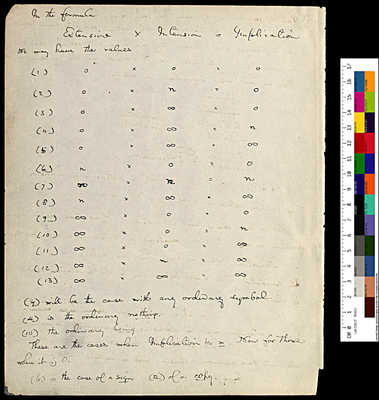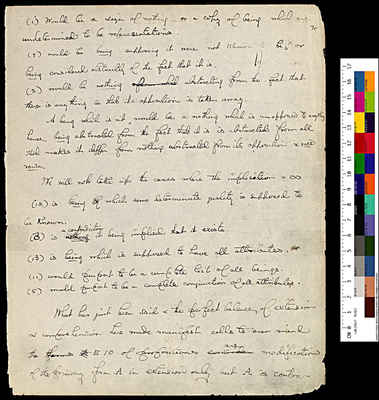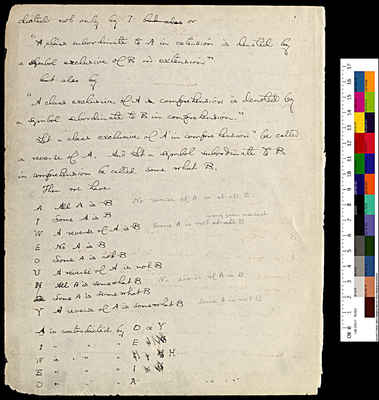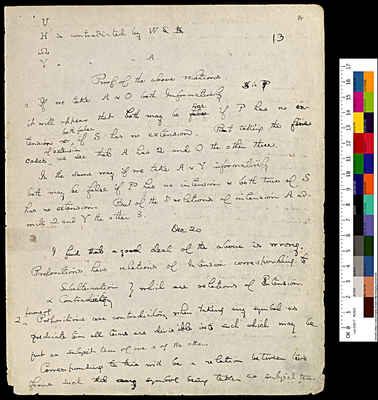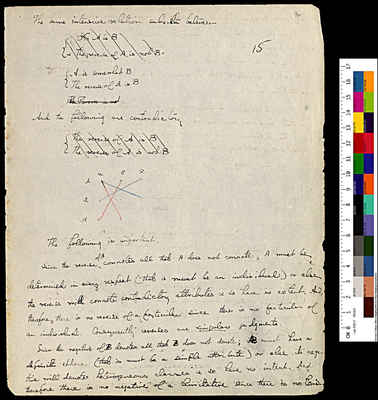Pages
10
In the formula
Extension × Intension = Implication
we may have the values
| (1) | 0 | × | 0 | = | 0 |
| (2) | 0 | × | n | = | 0 |
| (3) | 0 | × | ∞ | = | 0 |
| (4) | 0 | × | ∞ | = | n |
| (5) | 0 | × | ∞ | = | ∞ |
| (6) | n | × | 0 | = | 0 |
| (7) | n | × | n | = | n |
| (8) | n | × | ∞ | = | ∞ |
| (9) | ∞ | × | 0 | = | 0 |
| (10) | ∞ | × | 0 | = | n |
| (11) | ∞ | × | 0 | = | ∞ |
| (12) | ∞ | × | n | = | ∞ |
| (13) | ∞ | × | ∞ | = | ∞ |
(7) will be the case with any ordinary symbol.
(4) is the ordinary nothing.
(10) the ordinary being.
These are the cases when implication is n. Now for those where is is 0.
11
(1) would be a sign of nothing or a [why? copy?] of being which are undetermined to be representations.
(9) would be being supposing it were not known to be, or being considered abstractly of the fact that it is.
(3) would be nothing [????] which abstracting from the fact that there is anything so that its opposition is taken away.
A being which is [nil?] would be a nothing which is unopposed to anything hence being abstracted from the fact that it is is abstracted from all that makes it differ from nothing abstracted from its opposition and vice versa.
We will now take up the cases where the implication = ∞
(12) is being of which some determinate quality is supposed to be known.
(8) is a nothing a contradiction in being implied that it exists.
(13) is being which is supposed to have all attributes.
(11) would purport to be a complete list of all beings.
(5) would purport to be a complete conjunction of all attributes.
What has just been said [and? ∝?] the perfect balance of extension and comprehension here made manifest calls to our mind the forms A E 10 of propositions are consider are modifications of the primary form A in extension but A is contra-
12
dicted not only by [I ??] but also or
"A class subordinate to A in extension is denoted by a symbol exclusive of B in extension"
but also by
"A class exclusive of A in [comprehension ??] is denoted by a symbol subordinate to B in [comprehension ??]."
Let a class [exclusive ??] of A in comprehension be called a reverse of A. And let a symbol subordinate of B in comprehension be called [some what ??] B.
Then we have
A All A is B I Some A is B W A reverse of A is B E No A is B O Some A is not B U A reverse of A is not B N All A is somewhat B Ω Some A is somewhat B A is contradicted by O ∝ Y I is contracted by E ∝ W W is contracted by I ∝ H H E is contracted by I ∝ H O is contracted by A
13
8r
13
U H is contracted by W ∝ E Ω Y is contracted by A.
Proof of the above relations.
1. If we take A ∝ O both [informatively ??] it will of [appear ??] that both may be falsetrue if P has no [intension ??] [or ??] both false if S has no extension. But taking the five cases of extension that A has 2 and O the other three.
In the same way if we take A ∝ Y [informatively ??] both may be false if P has no intension & both true if S has no extension. But of the [5 relations ??] of intension A admits 2 and Y the other 3.
Dec 20
I find that a good deal of the above is wrong. [Propositions ??] have relations of Intension corresponding to [Subalternation && Contradiction ??] which are relations of Intension. 2 forms of [Propositions ??] are [contradictions ??] when taking any symbol as predicate [term ??] all [terms ??] are divisible into such which may be [put ??] as subject [term ??] one x of the other.
Corresponding to this will be a relation between two forms such that any symbol being taken as subject [term ??]
14
The same intensive relation subsists between (No A is B & The (reverse?) of A is not B.)
{A is somewhat B The reverse of A is B.
(The Reverse is not)
And the following are contradictory
({The reverse of A is B The Reverse of A is not B)
(figure: note use of colored lines)
The following is important: Since the reverse of A connotes all that A does not connote; A must be determined in every respect (that is must be an individual) or else the reverse will connote contradictory attributes & hso have no extent. And, there, there is no reverse of a particular since there is no particular of an individual. Consequently reverses are singular judgments. Since the negative of (A) B denotes all that (A) B does note denote; (A) B must have a definite sphere (that is must be a simple attribute) or else its nega tive will denote heterogeneous classes & so have no intent. And therefore there is no negative of a limitative since there is no (limit?).
